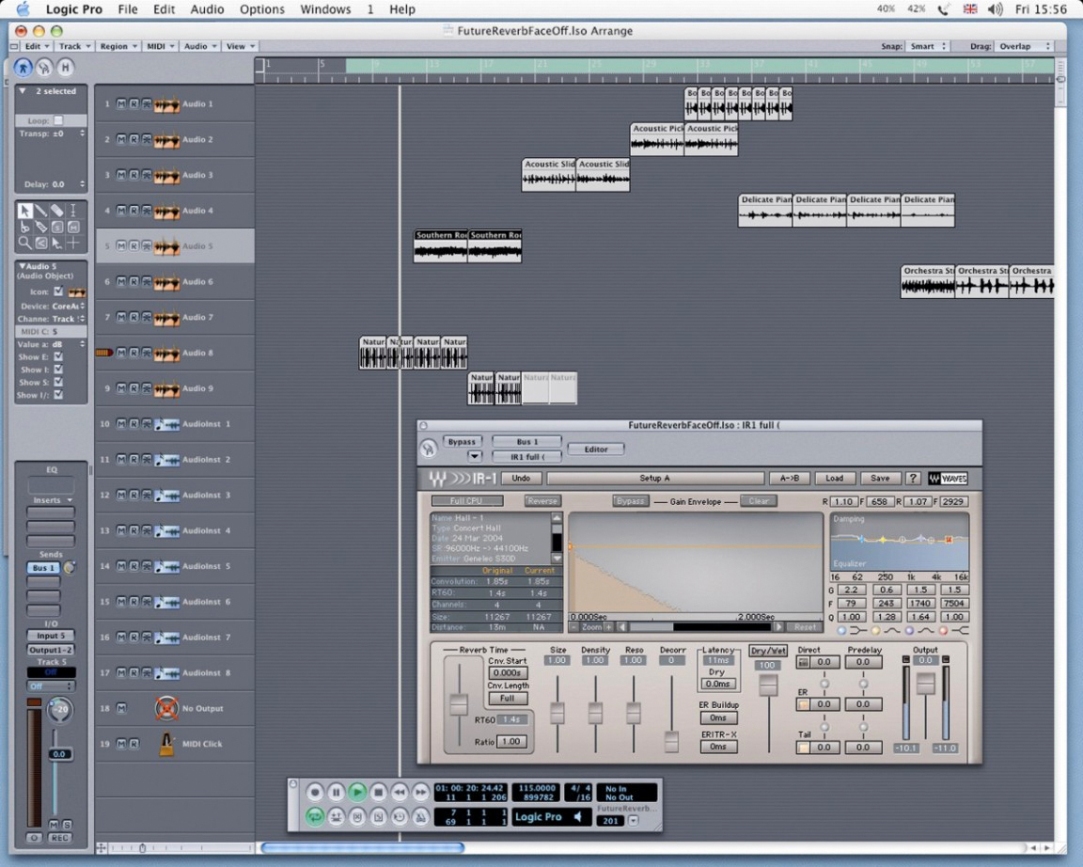MusicRadar Verdict
Can´t fault the sound, but the price and performance leave a lot to be desired.
Pros
- +
Create your own IRs. Deep, clear, realistic sound. Excellent online resources available.
Cons
- -
No automation or surround option. Limited reverb tails. Pricey for what it is.
MusicRadar's got your back
When IR-1 was first released, many reviewers praised it for its cunning blend of sonic excellence and deep editing power. However, it still lagged behind the competition in other key areas -- such as overall efficiency and the ability to record your own samples. So, testing the new version, it will be interesting to see if Waves have responded positively to this criticism. This is still one of the firm's high-end reverb offerings, after all, so it's reasonable to expect great things from it.
Unfortunately for any aeshetes out there the look of the plug isn't perhaps as striking as the others. Granted, it's in keeping with the rest of the Waves plug-in range and it's positively bristling with buttons and sliders, but its look does perhaps err on the side of functionality. Also, despite being the latest version available, the WaveShell fails Logic Pro 7's AU Manager inspection when you try to use it. You have to manually reselect it.
Details
Still, whenever you have the IR-1 up and running, you can appreciate all that it offers. You can shorten or lengthen a reverb's decay by up to four times, adjust the room size, fiddle with decay envelopes and control the characteristics of the damping, early reflections and decay tail, all while studying visual feedback via the main waveform window. There's also a separate window for the four-band Paragraphic EQ, which provides good tonal control.
Four faders take care of room size, density, resonance and decorrelation (pseudo stereo positioning), with further faders for Input, Output and the wet/dry mix. There's also a Convolution Length control to lighten the CPU load, as well as a separate CPU usage control, which offers a no-frills choice between Full and Low, with seemingly minimal impact on audio quality.
New to version 2 is the ability to capture your own IRs, which is a long-overdue addition. Also new are the Convolution Start control, to remove unwanted pre-delay; the Early Reflections Buildup Control; a Dry Gain mode; better preset handling and www.acoustics.net, Waves' home on the web for its growing IR-1 sample library. There are some superb places and spaces to download, including legendary UK concert halls and venues -- apparently, the company employs three people full-time to travel the world capturing the sound of such spaces. It's an excellent resource and the downloads are in WAV form, so any convolution plug-in can load them.
In use
The IR-1 delivers a highly realistic reverb sound, with an appreciable clarity and depth. Waves' collection of IRs covers everything from cathedrals to caves via studios and vintage gear, and there's a good deal of overlap with Altiverb 5 and Space Designer, too, so it's not as if one plug-in is leagues ahead in terms of the breadth of its IR collection. It really comes down to sound, convenience and personal taste.
If you like the Waves plug-in GUI, you'll be at home with the IR-1's utilitarian chic. If you're the kind of musician who thinks and tweaks parameters numerically, the IR-1 is again a good bet. If you just can't leave a sound alone, no matter how great it sounds already, the IR-1 may also be the one for you. However, there are still issues with the IR-1 that Waves has not tackled.
There's no automation. There's no surround option -- it's only available in the IR-360, a $1,200 HTDM-only plug-in. Reverb tails are limited to six seconds. And parameters don't change as you adjust them -- there is a pause in the reverb signal as a new impulse response is calculated, something that also interferes with Logic's transport controls.
Conclusion
When it comes down its sound, though, the IR-1 v2 is a very good option. Having this in your arsenal at mixdown could definitely help blow your listeners away. However, its current failings and idiosyncracies let it down in terms of day-to-day use.
It is undoubtedly the best cross-platform reverb, although PC users are spoilt for choice when it comes to convolution plug-ins. Logic users get Space Designer for free or the price of an upgrade, and Altiverb is simply the better product. There is a Light version with a stripped-down set of features, but even
that costs $400. Sometimes, it's difficult to understand Waves' pricing policy.
MusicRadar is the number 1 website for music makers of all kinds, be they guitarists, drummers, keyboard players, djs or producers...
GEAR: We help musicians find the best gear with top-ranking gear round-ups and high- quality, authoritative reviews by a wide team of highly experienced experts.
TIPS: We also provide tuition, from bite-sized tips to advanced work-outs and guidance from recognised musicians and stars.
STARS: We talk to musicians and stars about their creative processes, and the nuts and bolts of their gear and technique. We give fans an insight into the actual craft of music making that no other music website can.
“The most musical, unique and dynamic distortion effects I’ve ever used”: Linkin Park reveal the secret weapon behind their From Zero guitar tone – and it was designed by former Poison guitarist Blues Saraceno’s dad
Arturia’s V Collection gets a Roland JP-8000 emulation and lo-fi synth/sampler, along with five more instruments and a host of updates
Capture the sound of The Last of Us season 2's haunting soundtrack with Spitfire Audio’s latest software instrument, Ronroco by Gustavo Santaolalla











